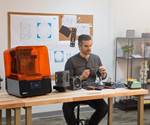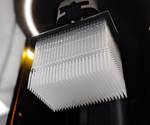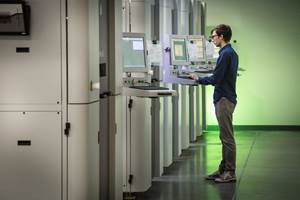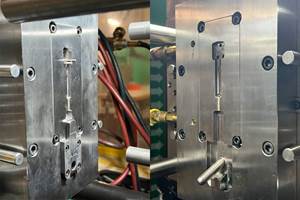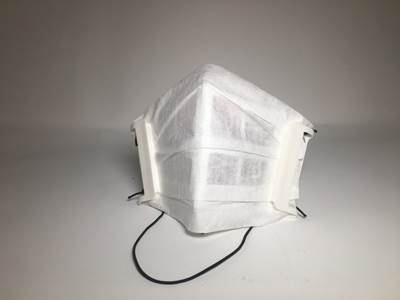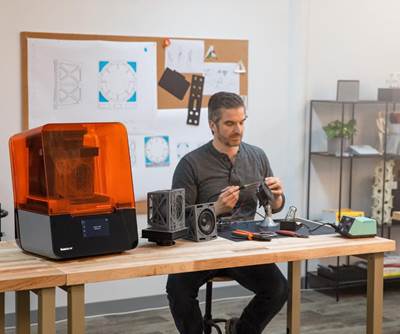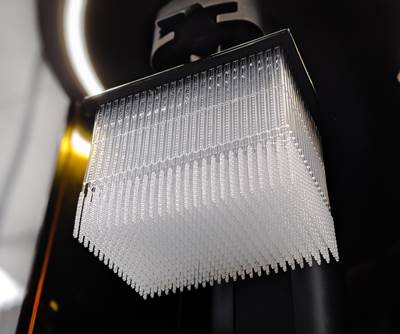20 Good Things to Come Out of 2020—Part 5
Additive manufacturing has emerged as the supply chain hero in many ways during the COVID-19 pandemic. While the recycling industry continues its push for a Circular Economy.
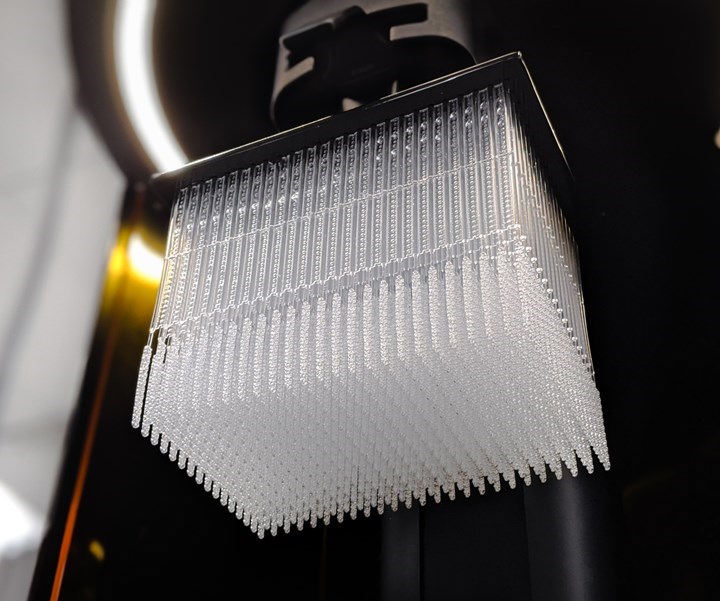
Resolution Medical was among the first manufacturers to use the Carbon Platform to 3D print a conformal lattice swab, creating a medical device for the testing of COVID-19.
The Strength of Additive Manufacturing
About a year ago, I interviewed several additive manufacturing companies asking for their predictions for 2020. The start of a new year always holds so much promise and many believed that this would be the year additive goes mainstream.
Well, it did. But maybe not in the way we all anticipated.
“When I think about this past year, I’m in awe of the massive efforts the manufacturing industry has made in response to the global pandemic,” said Ramon Pastor, head of 3D printing technology, operations, and metals, HP Inc. “It has truly been a watershed moment for digital manufacturing, in particular 3D printing, as many outside of the industry have now seen what it really means for manufacturing to be digital, agile, and local.”
One of my first articles about the pandemic was with Formlabs and Essentium where they discussed how their companies are responding to the COVID-19 crisis.
Dávid Lakatos, Formlabs' Chief Product Officer, said “accessible, professional 3D printers can be easily set up in locations that are not as affected by the novel coronavirus to keep production going, and in some cases even distributed to individual engineers and designers' personal work areas to keep prototyping, design, and small batch production running. Teams that used to work shoulder to shoulder can now work remotely, sharing designs electronically and printing locally.”
Blake Teipel, CEO and Co-founder of Essentium Inc. said, “Additive manufacturing enables a company to shift its sourcing of parts from remote locations like China to on-site production facilities. It also accelerates time to market, because they can print out the parts they need in a matter of hours, rather than wait days or weeks to receive the parts from a supplier.”
Applications Born Out of Necessity
There are so many articles that showed how 3D printing was used to help produce products to combat the pandemic. Essentium provided a protective mask kit comprised of a reusable 3D printed mask frame and filtration media. They worked with the Texas Division of Emergency Management, the Texas Military Department and other groups at a state level to supply PPE and also supplied 3D printed face masks for Sulzer employees.
In the wake of the pandemic, HP and its global network of partners and customers worked quickly to respond and deliver Personal Protective Equipment (PPE) and other critical parts to those on the front lines. More than five million parts have been produced to fill urgent needs including face masks, face shields, mask adjusters, nasopharyngeal test swabs, hands-free door openers, and respirator parts.
Marie Langer, CEO of EOS, said that some of the most prevalent 3D-printed PPE applications stemming from the pandemic include face masks, test swabs, ventilators, a special valve for more protection on ventilator masks, ventilator spare parts, safety glasses, and a customized framework for face shields. Fitz Frames, for example, an eyewear company that works with EOS to produce custom 3D-printed lenses and frames, launched Fitz Protect, safety glasses designed in conjunction with frontline medical professionals for both enhanced coverage and droplet protection, and made-to measure comfort during long shifts.
The Carbon Digital Manufacturing Platform was used to produce 1M+ nasopharyngeal swabs per week by Resolution Medical, an in vitro diagnostic and medical device manufacturer. Carbon SVP of Materials Jason Rolland said that the resin that was used was not designed for those purposes, in fact it’s used to make dental night guards. However, with a lot of engineering, they found that the resin checked all the boxes needed for the swap application. It had the right balance of properties to make a soft, flexible swab with appropriate strength that could be printed with precision using the Carbon M2 at 75 micron pixels.
Adaptability
Having a background in additive manufacturing was a huge plus in 2020. In this article, GM details how the company’s expertise in additive manufacturing helped turn automotive production to medical production. In April, GM entered into contract with the U.S. Department of Health and Human Services to deliver a 30,000-unit order for critical care ventilators, in conjunction with Ventec Life Systems, by the end of August. The company reverse-engineered part data for tooling fixtures from the original ventilator manufacturer, and started 3D printing them the next day. All 3D printed tooling used for critical care ventilators was created on Stratasys systems.
Changes to the Supply Chain
Langer, of EOS, said that COVID-19 caused a major disruption in the global supply chain, leading to a high-demand for locally developed and manufactured cost-effective and reliable medical supplies, such as nasal swabs and face shields.
“Here, AM is a perfect solution, enabling a distributed production approach, i.e. a decentralized production practiced by enterprises using a network of geographically dispersed manufacturing facilities that are coordinated using IT. These production facilities can be owned by a single OEM (original equipment manufacturer), or they can be a formal or informal network of service providers or suppliers. This method can increase transparency of supply chains, increase flexibility of production, reduce warehousing and shipping costs, easily adapt products to meet individual or regional tastes and reduce product carbon footprint.”
“As we look ahead, 3D printing will play a distinct role in accelerating the transformation of global supply chains to make them more efficient and flexible.”
According to HP’s Digital Manufacturing Trends Report—a 2020 global study by HP conducted by SME Media/Research that surveyed 3D printing and digital manufacturing decision makers across three continents and nine geographic areas—more than nine-in-ten respondents said they are investigating new production/supply chain models, with 59% evaluating hybrid models and 52% looking into localized production.
“For manufacturers and consumers alike, COVID-19 has been a reminder of our infrastructure fragility and has become an accelerant for change in the industry. The global supply chain was upended in ways never seen before, and 3D printing proved to be a critical part of the solution,” said Pastor of HP.
Investments in Recycling
Despite all the challenges of 2020, there were plenty of investments and new technology advancements in recycling proving that the push toward a Circular Economy can withstand anything. Here are some of the bigger news items:
French biotech company Carbios has produced the first clear plastic bottles from enzymatically recycled textile waste. The first phase of the company’s demo plant is scheduled to launch in the second quarter of 2021.
Nova Chemicals will sell recycled low/linear low-density polyethylene (r(L)LDPE) produced by Revolution. Nova will begin to provide these resins in January 2021.
AmSty and Agilyx announce the successful completion of a fully circular pathway for polystyrene recycling by receiving a ISCC (International Sustainability and Carbon Certification) PLUS certification.
Green Impact Plastics seeks to make PET thermoforms the next big recycling success story.
20 Good Things to Come Out of 2020—Part 1
20 Good Things to Come Out of 2020—Part 2
20 Good Things to Come Out of 2020—Part 3
20 Good Things to Come Out of 2020—Part 4
Related Content
NPE 2024: Additive Manufacturing Assisting, Advancing Plastics Processing
Exhibitors and presenters at the plastics show emphasized 3D printing as a complement and aid to more traditional production processes.
Read MoreGetting into Plastics Additive Manufacturing? Avoid these Six Common Errors
There are a lot of 3D printing technologies out there, and it’s not uncommon for processors new to additive manufacturing to get tripped up. Here are some typical snafus, along with advice on how to avoid them before you start making parts.
Read More3D Printing of Injection Molds Flows in a New Direction
Hybrids of additive manufacturing and CNC machining can shorten tooling turnaround times.
Read MoreBusiness Slowing? There's Still Plenty of Stuff to Do
There are things you may have put off when you were occupied with shipping parts to customers. Maybe it’s time to put some of them on the front burner.
Read MoreRead Next
Video: Essentium and Sulzer Discuss 3D Printed Face Mask Project
In this video interview, Blake Mosher of Essentium and Darayus Pardivala of Sulzer talk about Essentium’s work in creating 3D printed face masks for Sulzer employees.
Read More3D Printing Helps Keep Production Going During the Coronavirus Crisis
Formlabs and Essentium both discuss how their companies are responding to the COVID-19 crisis and how 3D printing can help eliminate potential supply chain disruption.
Read MoreCarbon 3D Prints Test Swabs and Face Shields in Response to the Coronavirus
Resolution Medical is among the first manufacturers to use the Carbon Platform to 3D print a conformal lattice swab, creating a medical device for the testing of COVID-19.
Read More


